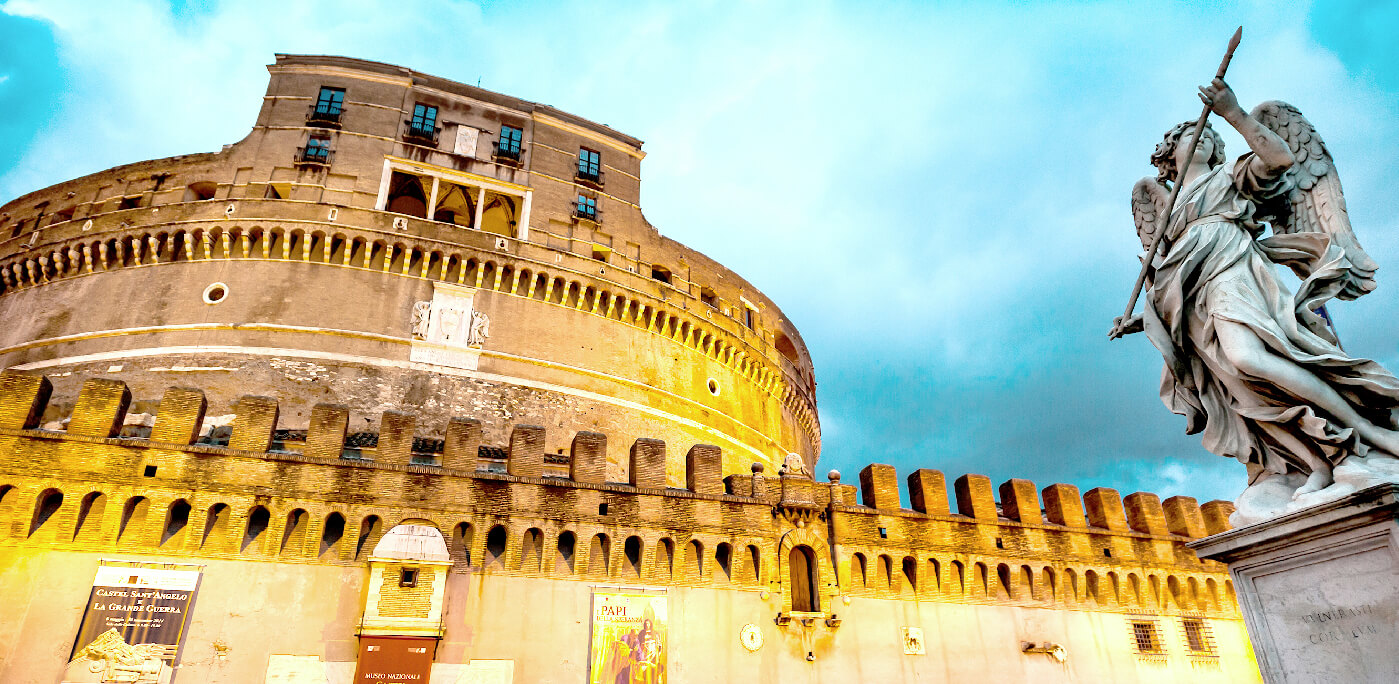When visiting Rome, I like staying close to the Vatican: there’s something magic in seeing “il cupolone” first thing in the morning that I wouldn’t change for anything. There’s something else I regularly do when there, I always cross the Tiber on Ponte Sant’Angelo. “How touristy” you may think and, yes, you’re right, I don’t deny to succumb every now and then to the guilty pleasure of behaving like a first timer in Rome, even if I know the capital pretty well by now. Yet, that bridge is just breathtaking, with all its angels guarding waters and skies and I always, always feel as I were the only one stepping on its “sanpietrini” while crossing, just like an Empress walking towards her castle. What castle? Castel Sant’ Angelo, of course which, if you come from the Tiber, stands haughty and timeless just in front of you.
If you’ve been to Rome, you probably know a thing or two about Castel Sant’Angelo: for example, you’re probably aware it was built upon the mausoleum of Emperor Hadrian and that it’s been protection to the Vatican and its popes for more than fifteen centuries. You probably also know there is a fortified passage running for 800 meters between Vatican city and the castle itself, commonly known as “il passetto” or “el corridore” in local roman dialect. “Il passetto “ was built for pope Alexander IV Borgia, at the end of the 15th century, and was used by many a pope to seek refuge within the strong, protective walls of Castel Sant’Angelo.
Something not many know, however, is that Castel Sant’Angelo used to host the Vatican’s high security prisons, where many an important name of Italian history got imprisoned throughout the centuries.
The Historical Prisons of Castel Sant’Angelo
The Prisons are located underneath the Cortile della Balestra, also known as Cortile del Pozzo. As mentioned, they were, very likely, built under request of pope Alexander IV Borgia, even though part of their structure, such as the round corridor connecting part of the cells, is original to the castle’s roman structure. Borgia had already existing rooms adapted to cells and had other built on purpose; his is also Castel Sant’Angelo’s well, decorated with his own coat of arms.
Secret prisons, they’re called, and their structure and look, still today, does everything to remind visitors of their mysterious past: accessed through a small door is the prisons’ parlor, which leads to the above mentioned semi-circular corridor of imperial origin. Along it, the first signs of imprisonment, in the shape of three small, claustrophobic cells. Two more detention areas form the rest of the complex: these are interesting both archeologically and historically, as the original roman walls of the mausoleum are visible within them. They’ve also been home to Benvenuto Cellini, renaissance goldsmith and artist, author of a famous autobiography: here, Cellini notes how he spent time drawing the features of a Resurrecting Jesus and God Father on the walls of his cell, drawings which can still be seen, albeit rather faintly, in one of the prison’s cells.
Cellini is considered one of the prisons’ most famous guests not only because he was a known artist, but also because he’s one of the very few who managed to escape. He did it through, it seems, the window of an external privy still extant today. As a matter of fact, he was imprisoned because of personal diatribes with Pier Luigi Farnese who fabricated accusations against Cellini to have him locked. Mind, Cellini wasn’t exactly a goody-two-shoes (he had a murder or two to pay for, papally condoned because of his service to the Vatican) so his stay in the prisons of Castel Sant’ Angelo was, somehow, at least morally justified.
Fast forward a couple of centuries and meet another of the prisons’ most celebrated guests: the Count of Cagliostro. Defined a “powerful mix of ingenuity and deceit, genius and charlatanry, mysticism and intemperance” Cagliostro was imprisoned because of his unclear affairs and his penchant for necromancy and magic, denounced by his very own wife. Of course, the Inquisition could not let a man of such a calibre go, and condemned him to death. Cagliostro, possibly thanks to his strong link with Freemasonry, ended up having his death sentence turned into life in prison. He was to be moved to San Leo prisons, in Emilia Romagna, where he died.
History, folklore and archaeology find a beautiful and interesting meeting point in Castel Sant’Angelo, and a lesser known, yet just as interesting, gem in its prisons. They’re part of the Castle’s tour and can be visited, along with the museum every day from 9 am to 7.30 pm.





























